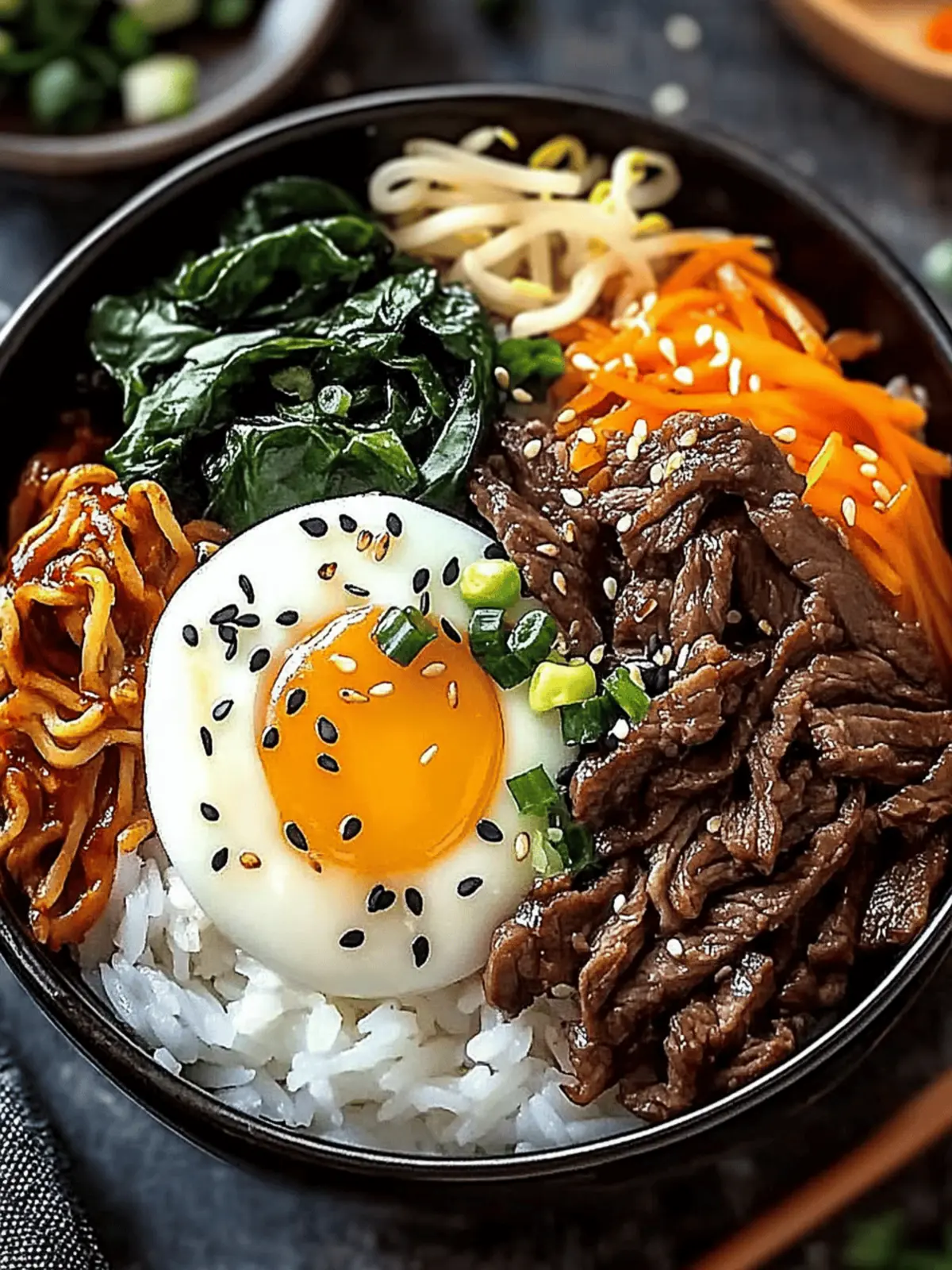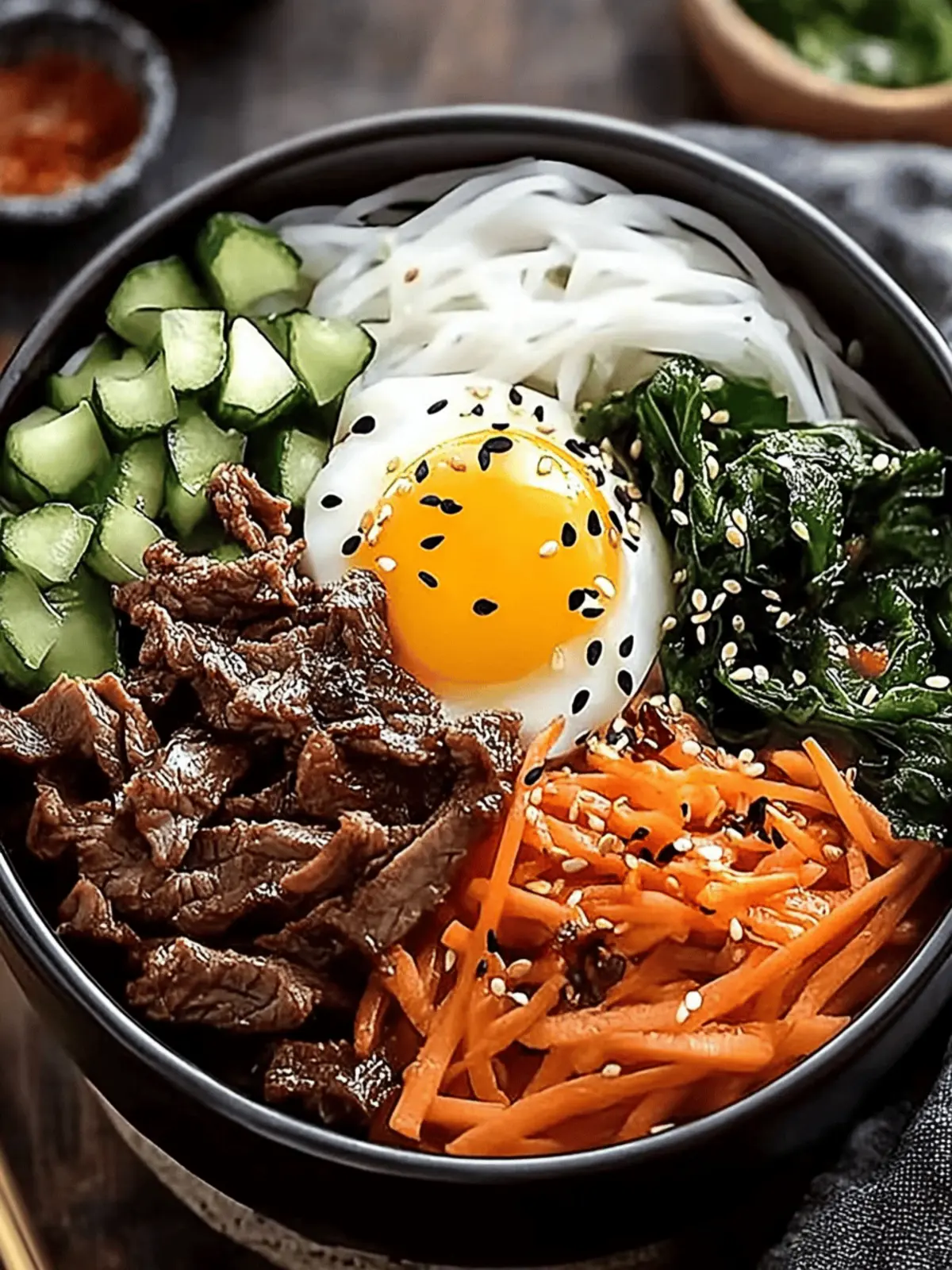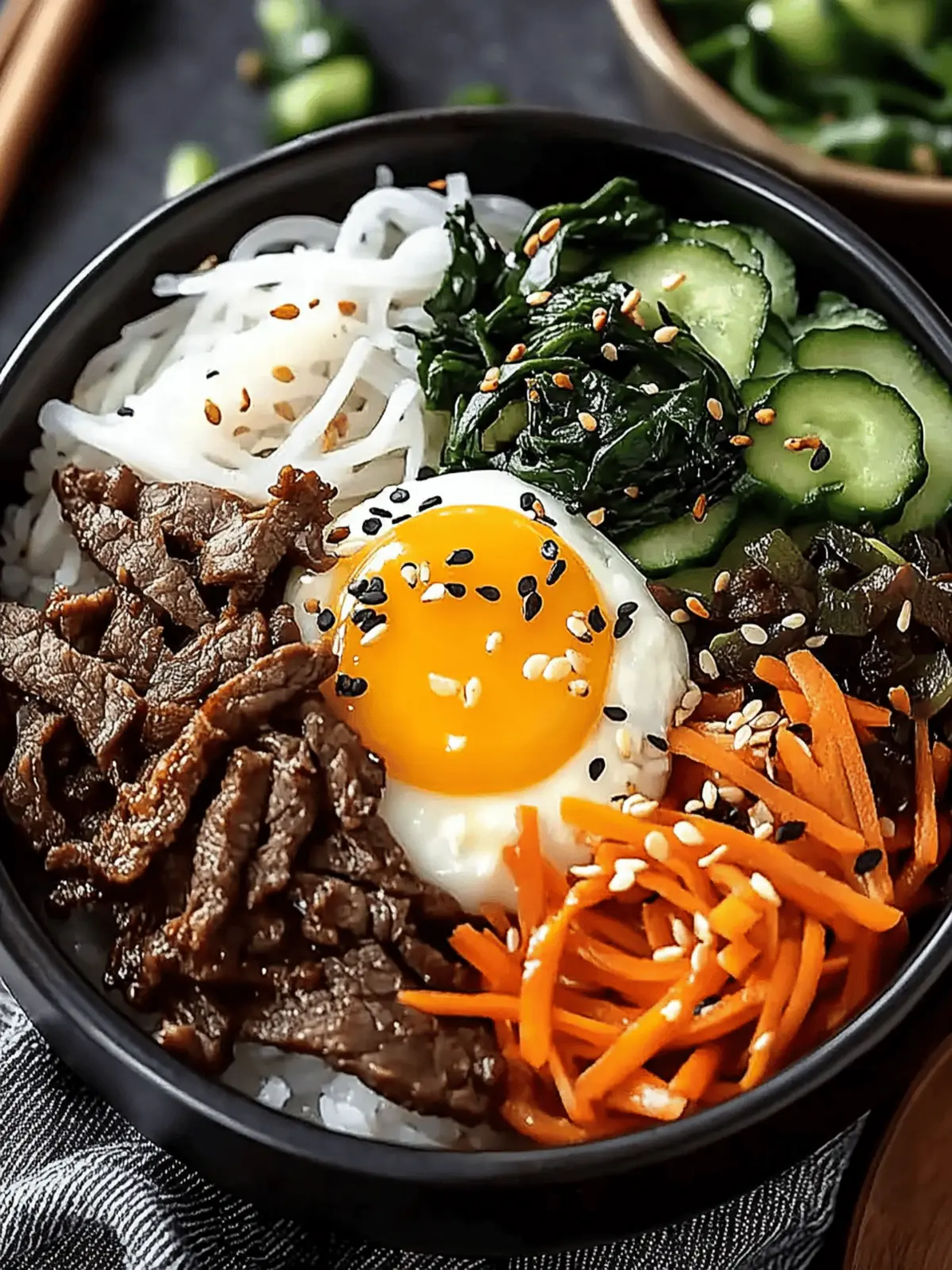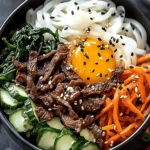There’s something utterly satisfying about the process of assembling a bowl that bursts with color and flavor, and my Korean Beef Bibimbap Bowl is no exception. The aroma of sizzling beef mingling with the earthy notes of sesame oil instantly transports me to bustling Seoul markets, where the vibrant energy is matched only by the delicious food. This dish is not just visually stunning; it’s a canvas for your culinary creativity, inviting you to mix and match fresh vegetables and proteins according to your mood or dietary preferences.
Whether you’re looking for a nourishing weeknight dinner that comes together in a flash or a show-stopping centerpiece for your next gathering, this customizable bowl offers it all. Juicy marinated beef, topped with a golden-fried egg, all served over warm, sticky rice—it’s a delightful medley of tastes and textures that will impress even the most discerning palates. Plus, with easy swaps for vegetarian options, everyone can enjoy this hearty dish. Let’s dive into the recipe and discover how to bring a taste of Korea into your own kitchen!
Why is the Korean Beef Bibimbap Bowl a Must-Try?
Colorful, Eye-Catching Presentation: Each bowl is a feast for the eyes, artfully layered with vibrant vegetables that make mealtime exciting.
Customizable Delight: Want to switch it up? This recipe allows you to mix proteins and veggies to suit your tastes or dietary needs.
Nutrient-Packed Meal: Loaded with fresh ingredients, it’s a wholesome option that balances protein, carbs, and vitamins all in one bowl.
Time-Saving: This dish comes together quickly, making it perfect for busy weeknights without sacrificing flavor or nutrition.
Crowd-Pleasing Comfort: Impress family and friends with a dish that captures the authentic flavors of Korea while being adaptable to everyone’s preferences.
Korean Beef Bibimbap Bowl Ingredients
For the Rice
• Short-Grain White Rice – Perfect for its sticky texture, it holds the bowl’s ingredients beautifully; avoid long-grain rice for best results.
For the Beef Mixture
• Ground Beef – A rich protein source that delivers deep flavor; substitute with ground turkey or tofu for a lighter or vegetarian twist.
• Gochujang Sauce – Infuses the dish with spice and depth; adjust the amount according to your heat preference.
• Low-Sodium Soy Sauce – Adds umami and seasoning to the blend; tamari is a great gluten-free alternative.
• Sesame Oil – Enhances the flavor profile; can be swapped for vegetable oil if needed.
For the Vegetables
• Carrots (Julienned) – Adds color and crunch; can be replaced with bell peppers or radishes for fun variations.
• Fresh Spinach – Provides essential nutrients and a vibrant green layer; swap with kale or bok choy if desired.
• Zucchini (Sliced) – Offers moisture and mild flavor; cucumber slices are a refreshing substitute.
• Bean Sprouts – Contributes a satisfying crunch; shredded cabbage or broccoli work well as replacements.
For the Topping
• Eggs – The crown of the dish, providing richness; for a vegan option, consider using avocado instead.
This recipe for the Korean Beef Bibimbap Bowl is not only nourishing but also makes mealtime a joyful experience, drawing on a medley of flavors that anyone would love!
How to Make Korean Beef Bibimbap Bowl
- Prepare Rice: Begin by cooking the short-grain white rice according to package instructions, which typically takes about 20 minutes. Once done, fluff it gently with a fork and set aside.
- Cook Beef: In a large skillet, add ground beef and brown it over medium-high heat for about 5-7 minutes. Use a spatula to break it apart as it cooks, draining any excess fat if needed.
- Add Flavor: Stir in gochujang sauce, low-sodium soy sauce, and sesame oil to the beef mixture. Allow it to simmer on low heat for about 5 minutes, letting the flavors meld beautifully.
- Sauté Vegetables: In the same skillet or another pan, add sesame oil and cook the carrots, zucchini, spinach, and bean sprouts over medium heat. Stir-fry for around 7 minutes until the vegetables are tender-crisp and vibrant.
- Fry Eggs: In a non-stick pan, fry the eggs sunny-side up for about 3 minutes. The whites should be set while the yolks remain runny, ideal for mixing into your bowl later.
- Assemble Bowls: Start layering by placing a generous scoop of rice at the bottom of each bowl. Top with the beef mixture, sautéed vegetables, and finish with a fried egg. Drizzle with extra gochujang for some extra kick if desired.
Optional: Top with sliced green onions or sesame seeds for added flair and flavor.
Exact quantities are listed in the recipe card below.
How to Store and Freeze Korean Beef Bibimbap Bowl
Fridge: Store leftover Korean Beef Bibimbap Bowl components in airtight containers for up to 3 days. Keep rice, beef, and vegetables separate to maintain freshness.
Freezer: For longer storage, you can freeze cooked beef and vegetables. Place them in freezer-safe bags, squeezing out excess air, and they’ll stay good for up to 2 months.
Reheating: To enjoy your bibimbap again, thaw frozen ingredients overnight in the fridge. Reheat the beef and vegetables in a skillet over medium heat until warmed through, and serve over fresh rice.
Assembling Fresh: For the best taste, it’s ideal to reheat components separately and reassemble them in a bowl just before serving.
Korean Beef Bibimbap Bowl Variations
Feel free to unleash your creativity and tailor this dish to your unique tastes or dietary needs!
- Dairy-Free: Swap the fried egg for sliced avocado for a creamy texture, maintaining that delightful richness.
- Vegan: Substitute ground beef with crumbled tofu or lentils, and replace the egg with extra veggies for a satisfying plant-based meal.
- Gluten-Free: Use tamari instead of regular soy sauce to enjoy the same great flavor without any gluten.
- Spicy Kick: Add sliced jalapeños or a sprinkle of red pepper flakes to the beef mixture for an extra layer of heat—perfect for spice lovers!
- Nutty Flavor: Drizzle with a touch of sesame oil just before serving for a fragrant finish that enhances the overall taste experience.
- Crunchy Toppings: Top with toasted sesame seeds or crushed peanuts for a delightful crunch that contrasts beautifully with the tender ingredients.
- Seasonal Veggies: Customize with seasonal vegetables like asparagus or snap peas for a fresh twist according to what’s available.
- Herb Infusion: Incorporate fresh herbs like cilantro or basil into the mix, adding a unique flavor profile that brightens every bite.
Your Korean Beef Bibimbap Bowl is a canvas—paint it with your favorite flavors and enjoy a personalized meal every time!
Make Ahead Options
These Korean Beef Bibimbap Bowls are an excellent choice for meal prep enthusiasts! You can cook the short-grain rice and sauté the vegetables up to three days in advance, storing them in airtight containers in the refrigerator. Additionally, the beef mixture can be prepared ahead of time; simply refrigerate it for up to 3 days as well. To maintain the quality of the vegetables and rice, make sure they are completely cooled before placing them in the fridge to prevent sogginess. When you’re ready to serve, simply reheat the beef and vegetables in a skillet over medium heat while frying up fresh eggs to top your bowls. You’ll have a delicious meal that saves you time during busy weeknights!
What to Serve with Korean Beef Bibimbap Bowl?
Imagine a vibrant table set to complement the delightful flavors of your bibimbap—each side adding its own charm to the meal.
- Kimchi: A traditional Korean side dish, this fiery, fermented vegetable adds a tangy crunch that elevates the entire experience.
- Cucumber Salad: Light and refreshing, a simple salad made with sliced cucumbers and rice vinegar brightens up the rich flavors of bibimbap.
- Sesame Spinach: This lightly salteared spinach side offers a nutty, savory kick that pairs beautifully with the savory beef and fresh veggies in your bowl.
- Steamed Edamame: Tender, green soybeans are packed with protein and make for a healthy, satisfying nibble that complements the main dish.
- Miso Soup: A warm bowl of miso soup can offer a soothing contrast to the hearty bibimbap, enriching the meal with savory umami flavors.
- Mango Sticky Rice: For dessert, this sweet, creamy dish serves as a delightful finish, offering a sumptuous comparison to the savory elements of your bibimbap.
- Green Tea: The gentle bitterness of green tea cleanses the palate, balancing the hearty nature of your Korean Beef Bibimbap Bowl while enhancing the dining experience.
Expert Tips for Korean Beef Bibimbap Bowl
- Choose the Right Rice: Ensure you use short-grain white rice for the perfect sticky texture that holds the ingredients together well in your Korean Beef Bibimbap Bowl.
- Opt for Marinating: Take the time to marinate your ground beef for at least 30 minutes. This step amplifies the flavor; however, avoid over-marinating to prevent the meat from becoming too salty.
- Sauté with Care: Lightly sauté your vegetables just until tender-crisp. This maintains their nutrients and vibrant color—crucial for a stunning presentation.
- Perfect Egg Technique: Fry your eggs just until the whites are set, leaving the yolks runny. This creates a rich, luscious sauce when mixed into the bowl.
- Customize Accordingly: Don’t shy away from experimenting! Feel free to substitute proteins or veggies based on personal preference, making your Korean Beef Bibimbap Bowl truly your own.
Korean Beef Bibimbap Bowl Recipe FAQs
What kind of rice is best for Korean Beef Bibimbap Bowl?
For the best texture, use short-grain white rice. Its sticky consistency helps hold all the delicious ingredients together. Avoid long-grain rice, as it won’t provide the same satisfying mouthfeel.
How should I store leftovers of the Korean Beef Bibimbap Bowl?
Store leftover components, like rice, beef, and vegetables, in airtight containers in the fridge for up to 3 days. To keep each ingredient fresh, it’s best to store them separately before reassembling your bowls.
Advertisement
Can I freeze the Korean Beef Bibimbap Bowl?
Absolutely! For freezing, store cooked beef and vegetables in freezer-safe bags. Be sure to remove excess air to prevent freezer burn. They’ll remain good for up to 2 months, perfect for quick meals later!
What if I have leftovers? How do I reheat them?
To enjoy your leftovers, thaw frozen ingredients overnight in the fridge. Reheat the beef and vegetables in a skillet over medium heat until warmed through. Serve atop fresh rice for a quick and delicious meal.
Are there any dietary considerations for the Korean Beef Bibimbap Bowl?
Yes! This dish can be easily customized for dietary needs—substitute ground beef with ground turkey, chicken, or even tofu for vegetarian options. Always check for allergies, especially with the gochujang sauce, which contains fermented ingredients.
How can I ensure my vegetables stay crisp?
To maintain crunch, sauté your vegetables over medium heat just until they’re tender-crisp, around 5-7 minutes. This not only keeps their nutrients intact but also enhances the visual appeal of your Korean Beef Bibimbap Bowl.
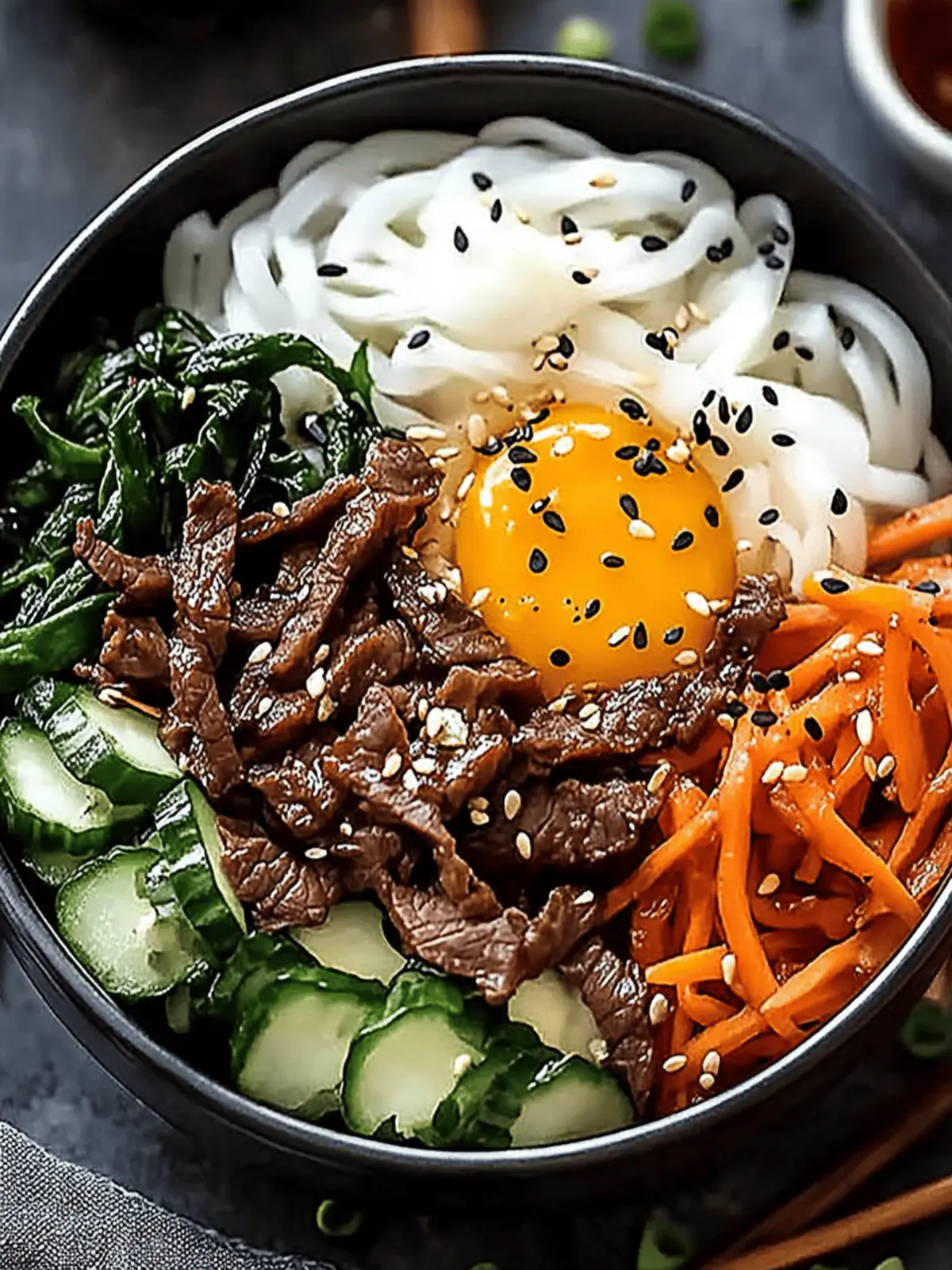
Korean Beef Bibimbap Bowl: Easy, Customizable Comfort Food
Ingredients
Equipment
Method
- Prepare Rice: Cook the short-grain white rice according to package instructions, about 20 minutes. Fluff with a fork and set aside.
- Cook Beef: In a large skillet, brown the ground beef over medium-high heat for 5-7 minutes, breaking it apart and draining excess fat.
- Add Flavor: Stir in gochujang sauce, low-sodium soy sauce, and sesame oil; allow to simmer on low heat for 5 minutes.
- Sauté Vegetables: In the same skillet or another pan, cook carrots, zucchini, spinach, and bean sprouts in sesame oil for about 7 minutes.
- Fry Eggs: Fry the eggs sunny-side up for about 3 minutes until the whites are set and yolks remain runny.
- Assemble Bowls: Layer rice, beef mixture, vegetables, and finish with a fried egg. Drizzle with extra gochujang if desired.

